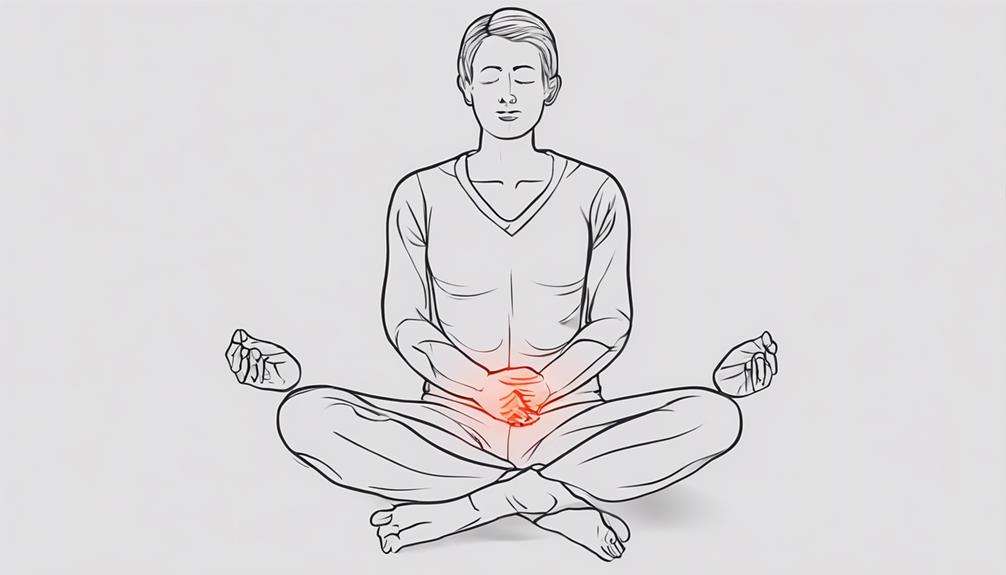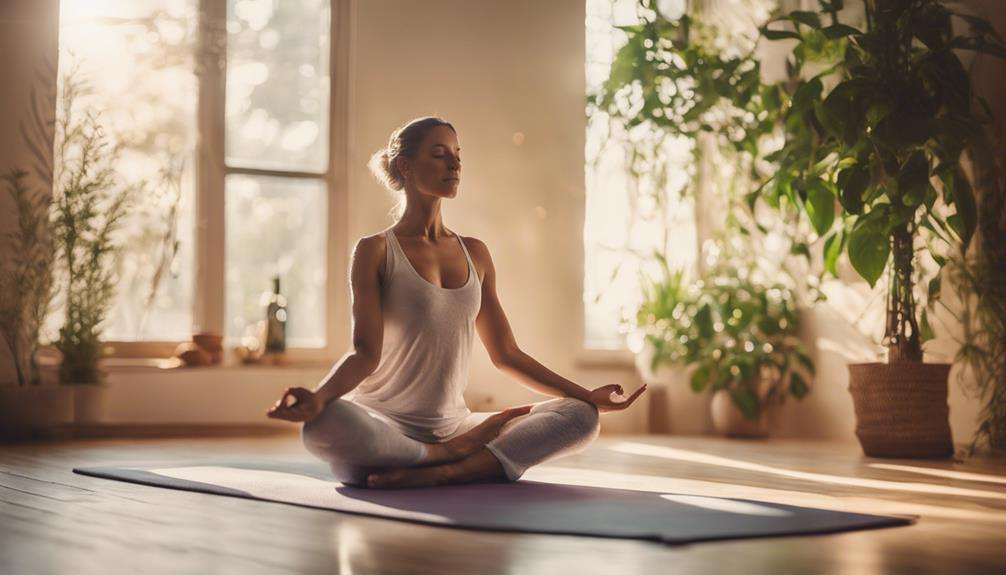You might think that managing anxiety through breathing techniques sounds too simple to be effective, but give it a chance.
Imagine feeling a sense of calm wash over you, the tension in your body easing away as you take a deep breath in…
Key Takeaways
- Diaphragmatic breathing reduces stress and improves mental well-being effectively.
- Box breathing offers a structured approach to relaxation and enhances emotional regulation.
- Pursed-lip breathing improves breathing efficiency and reduces breathlessness.
- Resonance breathing promotes balance, reduces anxiety, and enhances focus and stress resilience.
Diaphragmatic Breathing
When practicing diaphragmatic breathing, focus on deep inhalation into your abdomen rather than your chest to engage your diaphragm effectively. This belly breathing technique is instrumental in increasing the body's oxygen supply, leading to enhanced relaxation.
By actively involving the diaphragm, diaphragmatic breathing aids in reducing stress levels and managing anxiety, contributing to an overall improvement in mental well-being. Furthermore, research suggests that this breathing technique plays a crucial role in activating the parasympathetic nervous system, resulting in reductions in heart rate and blood pressure.
Regular practice of diaphragmatic breathing can also improve lung function, decrease muscle tension, and assist in anxiety and nervousness management. By incorporating this method into your daily routine, you can experience the benefits of a calmer mind and body, fostering a sense of well-being and tranquility.
4-7-8 Breathing Technique
Utilize the 4-7-8 breathing technique to promote relaxation and alleviate anxiety by following a specific pattern of inhalation, holding, and exhalation. This method is a powerful tool in managing stress and calming your mind. By practicing this technique regularly, you can experience a sense of control over your breathing and emotions, leading to improved overall well-being.
The 4-7-8 breathing technique helps regulate your breath, activate the body's relaxation response, and lower your heart rate. When you inhale for 4 seconds, hold for 7, and exhale for 8, you engage in a deliberate and calming breathing pattern that signals to your body that it's time to relax. This intentional breathing sequence can induce a state of relaxation and reduce feelings of anxiety.
Incorporating the 4-7-8 breathing technique into your daily routine can have a profound impact on your mental and physical health. So take a moment, find a quiet space, and practice this breathing exercise to bring tranquility and peace to your mind and body.
Box Breathing

Box breathing offers a structured approach to calming your mind and body. By following a simple pattern of inhaling, holding, exhaling, and holding again, you can effectively manage anxiety and nerves.
This technique provides a portable tool for achieving relaxation and improving overall well-being.
Benefits of Box Breathing
The benefits of incorporating box breathing into your daily routine extend beyond relaxation and stress reduction. This 4-4-4-4 breathing technique plays a crucial role in regulating the autonomic nervous system, enhancing focus, reducing anxiety, and boosting mental clarity.
Military personnel and athletes use box breathing to manage stress, improve performance, and build resilience in high-pressure situations. By balancing the sympathetic and parasympathetic nervous systems, box breathing aids in emotional regulation and overall well-being.
Consistent practice of box breathing empowers individuals to control their breathing patterns, fostering a greater sense of calm and composure when faced with challenges. Embrace the benefits of box breathing to cultivate a more centered and resilient mindset in your daily life.
How to Practice
To practice the box breathing technique effectively, start by finding a comfortable seated position in a quiet environment free from distractions.
Begin by inhaling deeply through your nose for a count of four, allowing your lungs to fill completely. Hold this breath for another count of four, feeling the air within you.
Then, exhale slowly through your mouth for four counts, releasing any tension or stress. Pause for a final count of four before starting the cycle again.
This rhythmic pattern engages the parasympathetic nervous system, promoting stress reduction, anxiety management, and emotional stability.
Consistent practice of box breathing not only enhances relaxation but also improves cognitive function, ultimately enhancing your overall well-being through this simple yet powerful mind-body practice.
Alternate Nostril Breathing
When seeking to alleviate anxiety and promote relaxation, consider incorporating the traditional yogic breathing technique of alternate nostril breathing, also known as Nadi shodhana.
This practice involves using your fingers to alternately close off one nostril while breathing in through the other, then switching to exhale through the opposite nostril. By balancing the flow of air between the left and right nostrils, this method helps harmonize the left and right hemispheres of the brain, promoting a sense of calm and focus.
Through regular practice, alternate nostril breathing can aid in reducing stress, relieving anxiety, and enhancing overall well-being. Just dedicating about 10 minutes to this technique can have profound calming effects on both the mind and body, making it a valuable tool in your arsenal for managing daily stressors and finding moments of peace and clarity.
Pursed-Lip Breathing

Consider adopting pursed-lip breathing as a valuable technique to regulate your breath, reduce feelings of breathlessness, and promote relaxation during moments of anxiety. Pursed-lip breathing involves inhaling through the nose and exhaling slowly through pursed lips, which can improve breathing efficiency.
This technique is beneficial for individuals with respiratory conditions, as it enhances oxygen exchange and helps in controlling the breathing rate. Research indicates that pursed-lip breathing is commonly utilized in pulmonary rehabilitation programs to enhance lung function and decrease sensations of breathlessness.
Lion's Breath Technique
Enhance your relaxation and reduce stress levels by incorporating the Lion's Breath Technique, a yogic breathing exercise known for its calming effects.
When practicing Lion's Breath, you inhale deeply through your nose and exhale with a forceful 'ha' sound.
This technique is highly effective for stress relief and relaxation, as research suggests it can lower perceived stress levels and induce feelings of tranquility.
By releasing tension in the face, jaw, and throat, Lion's Breath aids in overall relaxation, making it a valuable tool in managing anxiety.
Regularly integrating this practice into your daily routine offers a quick and efficient way to alleviate anxiety and enhance mental clarity.
Ocean Breath Technique

To shift focus to the Ocean Breath Technique, a soothing pranayama practice in yoga, consider incorporating this calming breathwork method into your routine for enhanced relaxation and anxiety relief.
Also known as Ujjayi Pranayama, the Ocean Breath Technique involves constricting the back of your throat while breathing, creating a gentle ocean-like sound. This technique is designed to regulate your breathing, increase mindfulness, and reduce anxiety by promoting relaxation.
By practicing Ujjayi breathing regularly, you can improve your focus, release tension, and enhance the mind-body connection. Moreover, this breathwork can aid in stress management, helping you find inner peace amidst life's challenges.
Embrace the Ocean Breath Technique as a powerful tool for calming your mind, relaxing your body, and managing stress effectively. Allow the rhythmic sound of your breath to guide you towards a state of tranquility and centeredness.
3-3-3 Rule Breathing
When feeling overwhelmed, the 3-3-3 breathing technique can be your go-to quick calming method.
By inhaling for 3, holding for 3, and exhaling for 3, you can swiftly reduce stress levels and ease anxiety.
This simple yet effective method promotes relaxation and helps you regain focus during tense moments.
Quick Calming Breaths
Utilize the Quick Calming Breaths (-3 Rule Breathing) technique to swiftly alleviate anxiety and nervousness by following a rhythmic breathing pattern of inhaling for 3 seconds, holding for 3, and exhaling for 3.
Quick Calming Breaths Benefits:
- Immediate Relief: Practicing this technique offers quick relief in stressful situations.
- Anxiety Reduction: Research indicates that rhythmic breathing patterns like the -3 Rule can help reduce anxiety by regulating the autonomic nervous system.
- Emotional Well-being: By centering your attention on the simple count of 3 for each breath phase, you can enhance your emotional well-being and promote relaxation.
Implementing Quick Calming Breaths into your routine can have a positive impact on your overall emotional health and help you manage anxiety effectively.
Stress Relief Technique
Implementing the stress relief technique of -3 Rule Breathing into your daily routine can significantly improve your overall well-being and mental clarity. This simple yet powerful method involves inhaling slowly for 3 seconds, holding the breath for 3 seconds, and exhaling for 3 seconds.
By practicing -3 Rule Breathing, you can regulate your breathing patterns and activate the parasympathetic nervous system, leading to a reduction in anxiety, calming of nerves, and promotion of relaxation. This technique is an effective way to manage stress, create a sense of calmness, and enhance mental clarity.
Make -3 Rule Breathing a part of your daily routine to experience its benefits in improving your overall well-being.
Anxiety Reduction Method
To enhance your relaxation and reduce anxiety, consider incorporating the -3 Rule Breathing technique into your daily routine. This 3-3-3 breathing technique involves inhaling for 3 seconds, holding for 3, and exhaling for 3, promoting quick relaxation. Here's how it can help you:
- Regulate Breathing Patterns: By following the 3-3-3 rule, you can manage acute anxiety and reduce stress responses by bringing your focus to your breath.
- Induce Calmness: This quick relaxation method induces a sense of calmness, allowing you to combat anxiety discreetly in various settings.
- Reset and Refocus: Use the 3-3-3 breathing technique to reset and refocus your mind during moments of heightened nervousness, promoting relaxation and calmness effectively.
Teddy Bear Breathing
Try out Teddy Bear Breathing, a delightful and effective technique for managing anxiety and stress by using a teddy bear as a focus point for deep breathing.
This technique involves holding a teddy bear on your belly and paying attention to its movement as you breathe deeply. By doing so, you engage in diaphragmatic breathing, which can help calm your nervous system and alleviate feelings of anxiety.
The presence of a comforting object like a teddy bear makes this deep breathing exercise accessible and enjoyable for individuals of all ages.
Teddy Bear Breathing not only provides stress relief but also serves as a mindfulness practice to help regulate emotions during times of heightened anxiety or nervousness.
Resonance Breathing

If you've found comfort in Teddy Bear Breathing, transitioning to Resonance Breathing can further enhance your relaxation and stress management techniques. This breathing method involves inhaling and exhaling for equal counts of time, usually around six seconds each, promoting balance and relaxation. Here's why resonance breathing can benefit you:
- Heart Rate Variability Improvement: Resonance breathing can enhance heart rate variability, which is a marker of overall health and stress resilience. By regulating your heart rate variability, you can better manage stress and promote emotional well-being.
- Anxiety Reduction and Calmness: Research supports the effectiveness of resonance breathing in reducing anxiety levels and promoting a sense of calmness. By synchronizing your breath with a specific rhythm, you can regulate your autonomic nervous system and improve your emotional well-being.
- Focus Enhancement: Regular practice of resonance breathing can lead to improved focus, reduced stress, and better management of anxiety symptoms. By incorporating this technique into your daily routine, you can enhance your overall well-being and stress resilience.
Frequently Asked Questions
What Is the 3 3 3 Rule for Anxiety?
When dealing with anxiety, remember the 3 3 3 rule. Inhale for 3 seconds, hold for 3, exhale for 3. This quick technique aids stress management, promotes relaxation, and helps with panic attacks, enhancing your mental health and well-being.
What Breathing Technique Is Best for Anxiety?
For anxiety, try box breathing. Inhale, hold, exhale, all in fours. This method swiftly lowers stress levels. Give it a go when tension creeps in. It's a simple technique with a powerful calming effect.
What Breathing Pattern Calms the Nervous System?
To calm the nervous system, diaphragmatic breathing engages your diaphragm by inhaling through the nose and exhaling through the mouth. This technique activates the parasympathetic nervous system, promoting relaxation and reducing anxiety effectively.
What Is the 4-7-8 4 Breathing Technique?
The 4-7-8 breathing technique is a powerful tool for relaxation. Inhale for 4 seconds, hold for 7, and exhale for 8. This practice aids in stress relief, calms the nervous system, and fosters a mind-body connection for inner peace.
Conclusion
Incorporating these breathwork techniques into your daily routine can help calm anxiety and nerves, promoting a sense of relaxation and well-being.
Did you know that studies have shown that deep breathing can reduce cortisol levels by up to 50%?
Take a few moments each day to practice these techniques and experience the positive impact on your mental and emotional health.
Remember, your breath is a powerful tool for managing anxiety.






